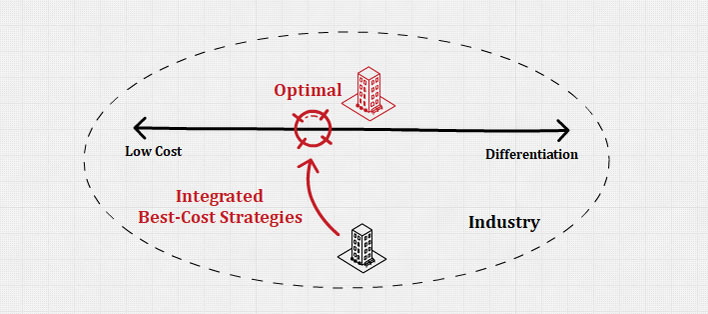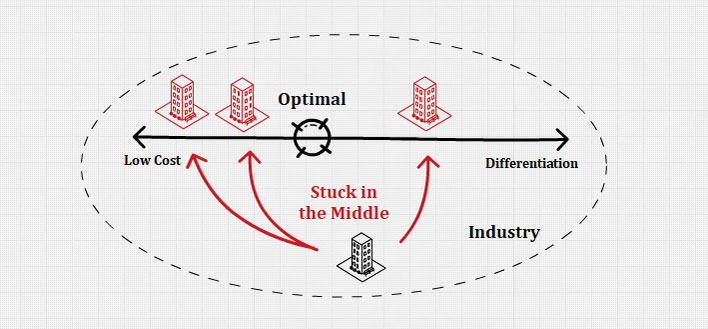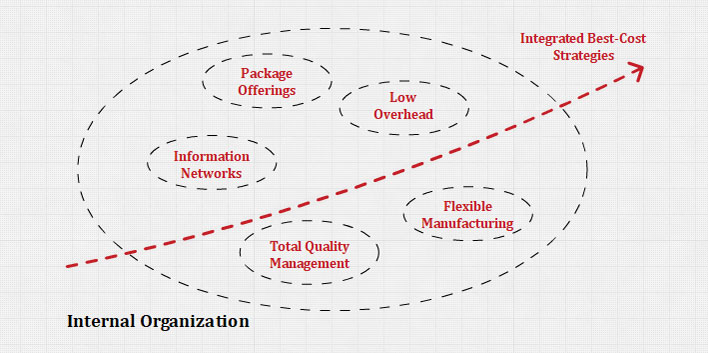Concept of Integrated Best-Cost Strategy

Definition
A best-cost strategy is a plan in which a firm charges relatively low prices and offers substantial differentiation at the same time.
The integrated best-cost strategy is becoming more common and perhaps necessary in many industries because of technological advances and global competition.
Interestingly, most emerging market firms have competed using the cost leadership strategy. At first, their labor and other supply costs tend to be considerably lower than multinational firms based in developed countries, as they follow a cost leadership strategy.
In recent years some of the emerging market firms are building their capabilities to produce innovation. Coupled with their capabilities to produce lower-cost goods, they may be able to gain an advantage over large multinational firms. As such, some of the emerging market firms are beginning to use this integrated low-cost and differentiation strategy.
Reasons to Use Integrated Best-Cost Strategy
Customer expectation on products and services: In general, most consumers want to pay a low price for products with somewhat highly differentiated features.
Because of these customer expectations, a number of firms engage in primary value-chain activities and support functions that allow them to simultaneously pursue low cost and differentiation. Firms that seek to do this are said to use the integrated cost leadership/differentiation strategy.
Higher profits than other strategies (cost leadership, differentiation): Because firms can charge a premium price for their products compared with the price charged by the pure cost leader, and because they have lower costs than the pure differentiator, they obtain at least an equal, and probably a higher, level of profit than firms pursuing only one of the generic strategies.
Companies have moved quickly to take advantage of new production and marketing techniques because the combined strategy is the most profitable to pursue.
Better adaptation to changes in external environments: Firms that successfully use the integrated cost leadership/differentiation strategy usually adapt quickly to new technologies and rapid changes in their external environments.
Objectives of Integrated Best-Cost Strategy
Firms that use this strategy must efficiently produce products with some differentiated features. They must be able to produce goods or services that provide the target customer some differentiated features at a relatively low cost. Thus, efficient production is the source of maintaining low costs, while differentiation is the source of creating unique value.
For the integrated best-cost strategy to be effective regardless of the industries, a combination of the firm’s tangible assets and intangible assets is highly recommended in facilitating the implementation of this strategy.
Risks of the Integrated Best-Cost Strategy
Difficulty in finding the right balance: Integrated best-cost strategy is a risky strategy because firms find it difficult to perform primary value-chain activities and support functions in ways that allow them to produce relatively inexpensive products with levels of differentiation that create value for the target customer.
Difficulty in integrating 2 targets: To properly use this strategy across time, firms must be able to simultaneously reduce costs incurred to produce products as required by cost leadership strategy, while increasing product differentiation as required by differentiation strategy. Creating unique features and communicating to customers why these features are useful generally also raises a firm’s costs of doing business.
Simultaneously concentrating on developing two sources of competitive advantage (cost and differentiation) also increases the number of primary value-chain activities and support functions in which the firm must become competent.
Such firms often have strong networks with external parties that perform some of the value-chain activities and/or support functions. In turn, having skills in a larger number of activities and functions makes a firm more flexible.
Firms may need to form alliances with other companies to achieve differentiation, yet alliance partners may extract prices for the use of their resources that make it difficult to meaningfully reduce costs.
Requirement of a long-term perspective: This strategy often necessitates a long-term perspective to make it work effectively, and therefore requires dedicated owners that allow the implementation of a long-term strategy that can require several years to produce positive returns.
Stuck in the Middle

Definition
Companies are said to be stuck in the middle because they have made product/market choices and perform value chain activities in such a way that they have been unable to obtain or sustain a competitive advantage.
Many companies, through ignorance or error, do not have the necessary plans to succeed in their chosen strategy. As a result, they have no consistent business-level strategy, experience below-average performance, and suffer when industry competition intensifies.
These firms do not offer features that are unique enough to convince customers to buy their offerings, and their prices are too high to compete effectively based on price. The firm’s cost structure is not low enough to allow it to attractively price its products and that its products are not sufficiently differentiated to create value for the target customer.
Firms that are stuck in the middle generally perform poorly because they lack a clear market or competitive pricing. These firms will not earn above-average returns and will earn average returns only when the structure of the industry in which it competes is highly favorable.
Reason for This Phenomenon
Difficulty in balancing cost leadership and differentiation: Either cost leadership or differentiation strategy requires a company to make consistent product/market/ distinctive competency choices to establish a competitive advantage.
Thus, a low-cost company cannot strive for a high level of market segmentation, as a differentiator does, and provide a wide range of products, because doing so would raise production costs too much and the company would lose its low-cost advantage.
A differentiator with a competency in innovation that tries to reduce its expenditures on research and development, or one with competency in responsiveness to customers through after-sale service that seeks to economize on its sales force to decrease costs, is asking for trouble because it will lose its competitive advantage as its distinctive competency disappears.
Improper evaluation of the internal organization and external environment: Some companies that find themselves stuck in the middle may have started out pursuing either cost leadership or differentiation strategies but then have made wrong resource allocation decisions or have experienced a hostile, changing environment.
It is very easy to lose control of a strategy unless strategic managers keep close track of the business and its environment, constantly adjusting product/market choices to suit changing conditions within the industry.
There are many paths to getting stuck in the middle. Quite commonly, a focuser gets stuck in the middle when it becomes overconfident and starts to act like a broad differentiator.
Differentiators, too, can fail in the market and end up stuck in the middle of competitors attack their markets with more specialized or low-cost products that blunt their competitive edge.
Insufficiency of investment: Try to use the integrated strategy is costly in that firms must pursue both low cost and differentiation. Many large firms will become stuck in the middle unless they make the investment needed to pursue both strategies simultaneously. No company is safe in a highly competitive global environment and each must be constantly on the lookout to make sufficient investment to take advantage of competitive advantages as they arise and to defend the advantages it already has.
What Firms Need for Integrated Best-Cost Strategy

Low-Overhead Business Model
One of the routes toward a best-cost strategy is for a firm to adopt a business model whose fixed costs and overhead are very low relative to the costs that competitors are absorbing.
Moving toward a best-cost strategy by dramatically reducing these expenses is a possible choice for many firms.
Flexible Manufacturing Systems
Recently, changes in production techniques, in particular the development of flexible manufacturing technologies, have made the choice between cost-leadership and differentiation strategies less clear-cut. With technological developments, companies have found it easier to obtain the benefits of both strategies.
A flexible manufacturing system (FMS) is a significant technological advancement. In essence, it is a computer-controlled process used to produce a variety of products in moderate, flexible quantities with a minimum of manual intervention.
One of the reasons for FMS to exist is that it creates relatively differentiated products at a relatively low cost. It does this by eliminating the low-cost versus product variety trade-off that is inherent in traditional manufacturing technologies. One of the methods to achieve this elimination is to integrate human, physical, and information resources. Another method is to achieve modularization of the manufacturing process (and sometimes other value-chain activities as well). These methods create the flexibility required to complete value-chain activities and support functions.
The second reason to use FMS is to manufacture a range of products at a cost comparable to that of the cost leader. FMS supports this by the use of flexible manufacturing cells as a means to reduce the costs of retooling the production line and the costs associated with small production runs. It can also help realize significant economies of scale is by standardizing many of the component parts used in its end products.
Traditionally, differentiation was obtainable only at a high cost, because the necessity of producing different models for different market segments meant that firms had to have short production runs, which raised manufacturing costs. In addition, the differentiated firm had to bear higher marketing costs than the cost leader because it was servicing many market segments. As a result, differentiators had higher costs than cost leaders, which produced large batches of standardized products. Thus, FMS helps to reduce these costs at a level comparable to cost leaders in the industry.
The substantial reduction of the costs of differentiation achieved via flexible manufacturing also promotes the current trend toward market fragmentation and niche marketing in many consumer goods industries, such as mobile phones, computers, and appliances.
Another reason for firms to use FMS is to change quickly and easily from making one product to making another. By doing this properly, firms can respond more effectively to changes in their customer’s needs.
The fourth reason for firms to apply FMS is to increase the firm’s capacity to serve the unique needs of a narrow competitive scope. It does this by reducing the lot size needed to manufacturing a product.
Package Offerings
In order to gain from differentiation and low cost at the same time, firms must take advantage of new developments in production and marketing, thus reducing both production and marketing costs.
In order to reduce the costs, firms must be able to limit the number of models in product lines. This is called package offerings, which essentially are options firms predesign, instead of letting consumers decide exactly what options they would want. This act of limiting the number of models substantially lower manufacturing costs, because long production runs of various product lines are now possible.
Thus, being able to do this, firms can reap gains from cost leadership and differentiation strategies at the same time.
Information Networks
Companies that use integrated cost leadership/differentiation strategy need assessment to information from their suppliers, distributors, and customers, in order to determine the trade-offs that they are willing to make between differentiated features and low cost.
Linking themselves with their suppliers, distributors, and customers helps firms effectively satisfy customer expectations in terms of product quality and delivery speed.
These links are to form the firm’s information networks.
One of these information networks is customer relationship management (CRM). An effective CRM system provides a 360-degree view of the company’s relationship with customers, encompassing all contact points, business processes, communication media, and sales channels.
Another information network can be derived from a firm’s supply chain. Such systems help firms to monitor their markets and stakeholders, thus allowing them to better predict future scenarios.
Thus, this capability of being able to assess information helps firms to make more comprehensive strategic decisions with effective knowledge of the organization’s context. Better quality managerial decisions require accurate information on the firm’s environment.
Total Quality Management Systems
In order for firms to implement the integrated cost leadership/differentiation strategy effectively, they must be able to simultaneously reduce costs while enhancing their ability to develop innovative products with higher quality.
To offer differentiated innovation and quality to customers at a relatively low price, firms must exceed customer’s expectations regarding innovation and quality, while also combining with the elimination of process inefficiencies to cut costs.
Thus, firms need a managerial process that emphasizes an organization’s commitment to the customer and to continuous improvement of all processes through problem-solving approaches especially based on empowering employees. This managerial process can help the firm develop the flexibility needed to identify opportunities that simultaneously increase differentiation and reduce costs.
This managerial process is total quality management (TQM).
This TQM system helps firms to (1) cut costs, (2) reduce the amount of time required to introduce innovative products with high quality to the market, and (3) essentially increase customer satisfaction.
TQM systems facilitate cost leadership strategies more effectively than they do differentiated strategies when each strategy is implemented alone. When used to pursue both strategies, it facilitates the potential synergy between the two.
TQM systems are available to all competitors so they may help firms maintain competitive parity, but alone they rarely lead to a competitive advantage.
Resources
Further Reading
- Best-Cost Strategy: Definition and Benefits (indeed.com)
- Best-Cost Strategy (tutorialspoint.com)
- A Complete Guide to Best Cost Provider Strategy (welpmagazine.com)
Related Concepts
References
- Hitt, M. A., Ireland, D. R., & Hoskisson, R. E. (2019). Strategic Management: Concepts and Cases: Competitiveness and Globalization (MindTap Course List) (13th ed.). Cengage Learning.
- Hill, C. W. L., & Jones, G. R. (2011). Essentials of Strategic Management (Available Titles CourseMate) (3rd ed.). Cengage Learning.
- Mastering Strategic Management. (2016, January 18). Open Textbooks for Hong Kong.